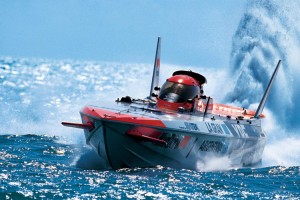 The idea of a uniformly hostile Iran has been baked into America’s strategic framework for decades–almost a generation. But the prospect of a thaw in the long-running Iranian-US Cold War would be fascinating–transforming the entire Arabian Gulf. If–IF–tensions recede, what will this mean? I threw together a few thoughts and questions for discussion:
The idea of a uniformly hostile Iran has been baked into America’s strategic framework for decades–almost a generation. But the prospect of a thaw in the long-running Iranian-US Cold War would be fascinating–transforming the entire Arabian Gulf. If–IF–tensions recede, what will this mean? I threw together a few thoughts and questions for discussion:
1. U.S. FORCE REDUCTION: Every single national strategic document has presumed, a constant state of tension with Iran, and declare that America expects to continue projecting power in the region. Here’s a quote from the Department of Defense National Strategic Guidance:
Our defense efforts in the Middle East will be aimed at countering violent extremists and destabilizing threats, as well as upholding our commitment to allies and partner states. Of particular concern are the proliferation of ballistic missiles and weapons of mass destruction (WMD). U.S. policy will emphasize Gulf security, in collaboration with Gulf Cooperation Council countries when appropriate, to prevent Iran’s development of a nuclear weapon capability and counter its destabilizing policies. The United States will do this while standing up for Israel’s security and a comprehensive Middle East peace. To support these
objectives, the United States will continue to place a premium on U.S. and allied military presence in–and support of–partner nations in and around this region.
As of this writing, we have two carriers and one big-deck amphib in the 5th Fleet AOR. Should things calm down, I would expect America’s large ships to go elsewhere and the U.S. footprint on the ground to shrink (which leads to some questions about what type of deployment the locals will want–a small-ship presence with a larger U.S. ground presence, or revert to the maintenance of larger ships, largely offshore).
2. SMALL BOATS: I have long believed that the “small boat threat” from the Iranians was driven more by sanctions and smuggling demands than any grand strategic plan to discomfit large combatants (read here, here, here and here) . The fact that the boats sparked bouts of American hand-wringing drove small-craft value, sure, but not as much as the prospect of making good money after a few cross-gulf smuggling runs!
3. FLEETS IN REGION: Should the sanctions recede and the interest in running smuggling fleets decline, I suspect the Gulf will see a shift towards larger, more conventional “showpiece” ships, probably carrying good aviation defenses (but they’d all likely remain in a poor state of readiness). Like any country, Iran likes nationalist displays, and I suspect there is some pent-up apatite for it. Also, for Iran, a more conventional Navy helps de-legitimize the religiously motivated Iranian naval militia. If Iran goes that route, and tries to become a more “regional” player than “local” force, then expect Saudi Arabia to answer with ship purchases of their own.
4. GROUND FORCES: While many defense companies are anxiously contemplating the impending diminishment of U.S. ground forces, I think the recapitalization of the region’s ground forces is something of a sleeper issue. Good old-fashioned ground warfare still matters in the Gulf. If Iran re-arms their tired ground forces, look to other countries to do the same.
5. AIR FORCES/AIR DEFENSE: Again, if Iran re-arms their tired air forces, look to other Gulf countries to do the same. One need only drive by certain desal facilities to know that tactical air defenses/missile defense demand is going to be huge. Saudi will be an early adopter of next-gen laser/gun-based missile defenses, and if the F-35 fails to enter into a few more arsenals in the region, I’ll be somewhat surprised.
6. CLIMATE FOR REFORM: If the U.S. heads wholesale for the exits, will our tolerance for tough treatment of social unrest by our regional allies vanish as well?
6. CHINA: As China’s interests in Iraq grow, and the U.S. footprint recedes, how will China respond? Will they step up their presence? How might a larger Chinese presence be received in the region? In particular, an uptick in purchases of Chinese ships and other defense material in this normally western-sourced region might pose some interesting (and worrisome) questions–and would be a very subtle means of expressing displeasure (or putting pressure on) the U.S..
7. WEAPONS OF MASS DESTRUCTION: In the region, proliferation of biological and chemical weaponry has proven to be more myth than materially significant. Nuclear weaponry will come next, with Iran, Turkey, Saudi Arabia the next likely proliferation hot-spots.
In closing, the struggle between the different Muslim sects will continue apace. How America navigates that uncomfortable rivalry, and, at the same time, competently navigates the other global players who will start operating in the region (China, and, yes, Japan) to protect their energy supplies, will be of enormous importance in the years ahead. I look forward to years of multi-dimensional chess, as Muslim sects and Israeli interests jostle for U.S. support and engagement.
It’s going to be tough. Lots of questions….How does the U.S. gracefully ramp-down presence while, at the same time, bolster our regional standing? How does the U.S. maintain the defense market share in the region as other countries become more aggressive–and possibly, more intimate–partners with Gulf states? And, for the Navy, as local Navies start contemplating the idea of developing “conventional” regional navies, complete with larger, “conventional” ships, how will our forces share what has been, for decades, a U.S./NATO-dominated lake?
Looking forward to more discussion. It’s a fascinating time in a very fascinating region.
